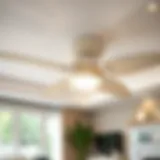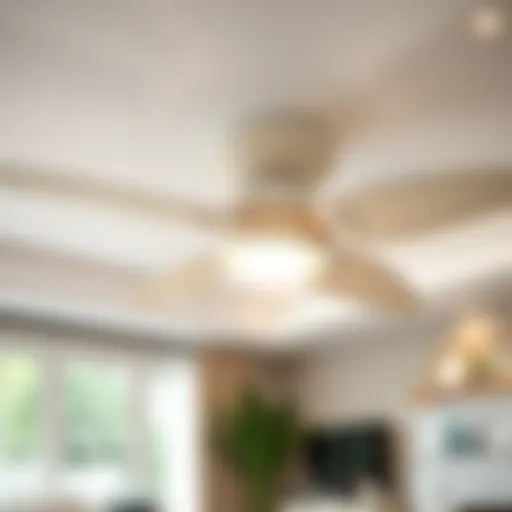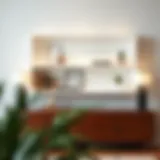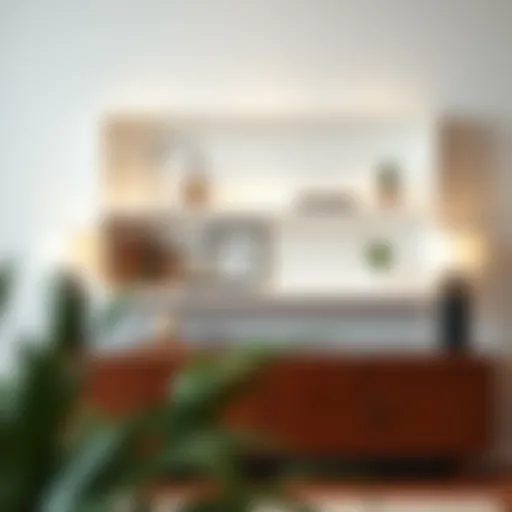Maximize Space with Shelf Divider Organizers
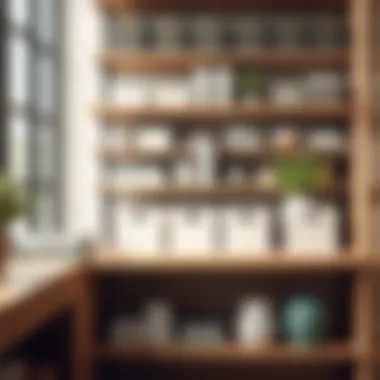

Intro
When it comes to organizing a home, shelf divider organizers can be a game changer. These unassuming tools play a pivotal role in maximizing space while improving the overall aesthetic of various settings, from kitchens to living rooms. In our quest for functionality and beauty, understanding the depth of these organizers is key. Not only do they serve practical needs, like maintaining order and accessibility, but they also give a polished look to any shelving arrangement.
The array of designs and materials available allows homeowners and designers alike to find options that complement their individual style. From sleek modern designs to rustic looks, there's something for everyone. But beyond mere appearances, the advantages of incorporating shelf dividers into one’s home organization setup can be substantial.
This guide will delve into the various aspects of shelf divider organizers—from their design and material considerations to thoughtful purchasing tips. Practical insights await for DIY enthusiasts looking to elevate their home spaces, ensuring every reader walks away with a comprehensive understanding of how to best utilize these items in their everyday lives.
Understanding Shelf Divider Organizers
When it comes to optimizing space and creating a more organized environment, shelf divider organizers play a pivotal role. They are not just mere accessories for your shelves; instead, they serve as essential tools that improve functionality and enhance the overall look of a space. Understanding shelf divider organizers involves knowing their purpose, history, types, and the manifold benefits they provide to homeowners and design enthusiasts alike.
Definition and Purpose
Shelf divider organizers are specially designed tools that divide spaces on shelves to facilitate better organization and preserve the aesthetic appeal of a room. Their primary purpose is to keep items separated, which can help to prevent clutter and make it easier to locate what you need when you need it. Whether it’s a stack of books, kitchenware, or decorative items, these dividers act as barriers that hold everything in place. By strategically placing dividers, one can maximize storage potential without sacrificing accessibility.
Historical Context
The concept of organizing spaces has been around for centuries, but shelf dividers as we know them have evolved significantly over time. Initially, shelves were simple wooden structures without any form of division. The need for compartmentalization arose alongside the growth of household items and kitchenware during the Industrial Revolution. As people's possessions grew, so did the awareness about effective space utilization. Hence, dividers began to appear, first made from wood and later from various materials.
Types of Shelf Dividers
There are several types of shelf dividers, each with its unique attributes and uses.
Adjustable Dividers
Adjustable dividers offer versatility, allowing users to modify the sections based on their individual needs. This adaptability is a significant draw for many people looking to customize their storage space. These dividers can be easily moved to create larger or smaller compartments, depending on what you are storing. Moreover, their key characteristic is their ease of installation, often requiring no specialized tools. They tend to be favored for their practicality in dynamic environments, such as a kitchen where storage needs may change frequently.
- Advantages: They’re flexible and cater to varying storage requirements.
- Disadvantages: If not secured properly, they can shift positions, which might lead to disorganization.
Fixed Dividers
Fixed dividers, in contrast, provide a more permanent solution. Once installed, they remain in place and don’t shift despite weight changes on the shelf. This stability is advantageous for those who want a straightforward organization system without the hassle of adjustments. Generally made of sturdy materials, fixed dividers are ideal for bookshelves or linens. Their unyielding nature helps in maintaining order at all times.
- Advantages: They offer consistent organization without the risk of movement.
- Disadvantages: They can limit flexibility in space usage since they cannot be adjusted once installed.
Multi-Tier Dividers
Multi-tier dividers are innovative solutions that maximize vertical space. These structures allow a single shelf to hold multiple layers of items, enabling users to store more without overcrowding. They are particularly beneficial in areas where height is available but horizontal space is limited. These dividers often come in innovative designs that feature tiered levels, which makes accessing items easier and more organized.
- Advantages: They significantly optimize space and enhance visibility of items.
- Disadvantages: They might not suit every decor style and could be viewed as bulky in smaller spaces.
In summary, understanding the various types of shelf divider organizers sets the foundation for effectively enhancing both functionality and the visual appeal of any room. From adjustable to fixed to multi-tier dividers, each type has specific traits that cater to different organizational needs seeking to elevate a home’s storage game.
Benefits of Shelf Divider Organizers
Shelf divider organizers bring various benefits that enhance both functionality and aesthetics of spaces. Homeowners, designers, and DIY enthusiasts can greatly profit from understanding these advantages, ultimately leading to well-organized and visually appealing environments.
Maximizing Space Utilization
When it comes to shelving, making the most out of the available space isn’t simply a matter of stacking items high. This is where shelf divider organizers shine. By breaking up expansive spaces into smaller, more manageable sections, they create designated areas for different items. It’s a bit like arranging a bustling marketplace; instead of everything jumbled together, each stall offers a distinct selection.
For example, in a kitchen, one can use shelf dividers to separate baking supplies from dinnerware. Not only does this stop chaos from rearing its ugly head, it optimizes vertical and horizontal space within cabinets. With dividers, items are stored upright, preventing damage to fragile containers, and making them easier to access. This practice can significantly increase efficiency, making sure everything you need is within arm's reach haven’t lost themselves in the depths of clutter.
Improving Accessibility
Accessibility is king. No one wants to play hide and seek with their belongings. By using shelf dividers, you ensure that everything has a dedicated spot and can be easily grabbed without rummaging around. Imagine an office shelf where books, files, and supplies are stacked randomly. It’s mayhem at its finest.
Dividers allow you to see exactly what you have in stock at a glance. Items are neatly arranged and readily available; it’s like having a trusty assistant who's well-versed in your inventory. For instance, in a craft space, fabric pieces can be organized by type or color, making it a breeze to find the perfect material for your next project. Every time you reach for something, it feels like a small victory rather than a chore.
Enhancing Aesthetic Appeal
Beyond their practical uses, shelf dividers also contribute significant aesthetic value. They can instantly elevate the overall look of a room. Think of a living room with a stark bookshelf. In its current state, it might resemble a hodgepodge of random items, but with carefully chosen dividers, you can create a sense of order that is visually pleasing.
For instance, mixing materials and colors can have a stunning effect. You could employ wood dividers for a rustic charm alongside sleek glass shelves for a modern touch. Investing in stylish dividers emphasizes personal taste, while integrating beautifully with your home’s decor. The end result feels polished and intentional rather than haphazard.
"An organized space is not just functional; it speaks volumes about your aesthetic sense and personal discipline."
Materials Used in Shelf Divider Organizers
When it comes to shelf divider organizers, the materials they are constructed from play a crucial role in their function, durability, and aesthetic appeal. Choosing the right material can significantly impact how well these organizers perform in the long run and how they integrate with your home’s decor. Each material has unique attributes that cater to different preferences and usage scenarios, making it essential for homeowners, designers, and DIYers to understand the strengths and limitations associated with each.
Wood
Wooden shelf dividers are often celebrated for their classic look and robust nature. They bring warmth and character to any space, blending well with rustic and traditional home styles. Solid wood dividers, like oak or cherry, tend to be quite sturdy, ensuring that they can withstand the weight of various items without bowing or warping.
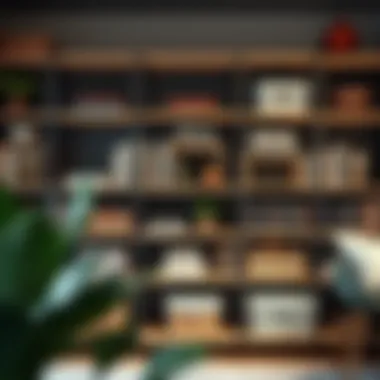

"Wood not only stands the test of time, but it also complements the surrounding decor beautifully, making it a popular choice for many."
One benefit of wood is its versatility. It can be stained or painted to match existing furniture, or left natural to showcase its unique grain patterns. Well-crafted wooden dividers can last decades, making them a smart investment. However, potential drawbacks include susceptibility to scratches and dents, and they often require more maintenance than other materials, such as regular polishing to maintain their shine and protect against moisture.
Metal
Metal dividers stand out for their sleek and contemporary design, often found in modern kitchens and offices. Options like stainless steel or wrought iron provide a strong, resilient framework, making them perfect for holding heavier items such as books or large kitchen supplies. Their durability means they won’t easily bend or break under pressure, which can be a game-changer in busy environments.
Not only are metal dividers practical, but they can also be stylish. Available in various finishes—including brushed, polished, or powder-coated—these organizers can add an industrial touch to your space. However, one must consider that metal can be prone to rust if not properly coated, especially in humid environments like kitchens or bathrooms.
Plastic
Plastic shelf dividers are often favored for their lightweight and colorful nature. They are typically less expensive and resistant to moisture and stains, which makes them friendly for a range of uses, from children’s toys to kitchen items. Heavy-duty options can provide the necessary support for moderate-weight items as well.
Another advantage of plastic is its ease of cleaning. Simply wipe them down with a damp cloth, and they’re good as new. Furthermore, they are available in multiple designs—including opaque and transparent variants—allowing for a customizable look. However, one should be cautionary of less durable plastic which may warp or crack over time, especially under stress or when exposed to extreme temperatures.
Fabric Covered Dividers
Fabric covered dividers add a unique tactile quality to shelf organization. Often dipped in versatile patterns, they offer a soft touch and can break the rigidity commonly associated with other materials. These are particularly popular in bedrooms and living areas, where aesthetic appeal is as much a priority as functionality.
Fabric-covered options can easily match the decor due to the plethora of colors and patterns available. They are lightweight and can be constructed over a frame, allowing some flexibility. However, it’s important to note that fabric will attract dust and may require regular cleaning or machine washing, which could be a concern for those with allergies or pets. Also, its load-bearing capacity is generally less compared to wood or metal, making it less suitable for heavier items.
Design Considerations
When it comes to organizing and enhancing our living spaces, the design of shelf divider organizers plays a crucial role. It's not just about functionality; it's equally about ensuring that these dividers harmonize with the overall aesthetics of your home. Understanding the design considerations can help you choose dividers that not only serve a purpose but also enrich the visual experience of the environment.
Matching Home Style
Every home has its own vibe, a unique character often highlighted by its décor. When selecting shelf dividers, it's essential to consider the style of your space. For instance, if your home has a rustic feel, wooden dividers that showcase grain patterns can enhance that aesthetic beautifully. Conversely, modern homes might benefit from sleek metal or acrylic dividers that offer a minimalist touch.
A practical approach to matching your home style could include:
- Assessing existing furniture and color schemes: Ensure that the material and color of the dividers don’t clash with your shelves or surrounding furniture.
- Incorporating theme: For instance, a beach-themed room may work well with dividers made from natural fibers or light, beachy colors.
"The best designs are ones that tell a story, connecting each piece to the next."
Choosing the Right Size
Size matters — this is particularly true for shelf dividers. Picking dividers that fit well within your space is paramount for both functionality and aesthetics. A divider that is too tall could overwhelm a low shelf, while one that's too short might not adequately support the items stored in an upright position.
When deciding on size, consider the following aspects:
- Shelf height and depth: Measure your shelves accurately to ensure that your divider selection fits comfortably.
- Intended use: Think about what you plan to store. If you're organizing books, a taller divider may be necessary, whereas a shorter one could suffice for small decorative items.
Color Coordination
Color can make or break the visual appeal of your organized space. A careful selection of colors that complement each other will enhance the overall aesthetic. It's wise to consider existing colors in the room and choose dividers that either blend in or create an appealing contrast.
Here are some tips for effective color coordination:
- Neutral tones: Opt for dividers in shades of white, beige, or grey for maximum versatility, allowing you to seamlessly incorporate them into varied color palettes.
- Accent colors: If a specific color inspires your room, consider using dividers in that color as an accent piece, drawing the eye and adding interest to the shelves.
Ultimately, design considerations are vital for creating an organized and aesthetically pleasing space. By choosing dividers that match your home style, are appropriately sized, and are color coordinated, you’ll not only enhance functionality but also elevate the ambiance of your environment.
Usage Scenarios
The practical application of shelf divider organizers stretches far and wide, adapting to various settings within a home or workplace. The right type of shelf organizers can make all the difference in creating a systematic approach to managing space. Whether for maximizing kitchen efficiency, enhancing workspace organization, or beautifying living room displays, these dividers play a pivotal role. Let's explore some key scenarios where shelf dividers shine.
Kitchen Organization
In the kitchen, shelf divider organizers transform chaos into clarity. When you're juggling jars, pots, and snacks, it’s easy for things to go haywire. Here’s why dividers matter:
- Maximized Storage Space: Dividers allow you to stack various items without toppling over. Think about that one shelf where all jars seem to play a game of chance. By using a divider, you can stabilize them and prevent clattering.
- Easy Access: Each item has its designated spot. You don’t have to play hide and seek with spices anymore; a well-placed divider brings them into the limelight.
- Hygiene: Keeping things organized also means less dust and dirt accumulating on unused items. Cleaner kitchens are happier kitchens.
Imagine reaching for a jar of pickles without having to move half of your pantry! Such convenience saves time and effort. Kitchen dividers can be found in adjustable formats, accommodating various heights of containers and bottles, which aligns perfectly with the routines of home cooks.
Office Spaces
The workspace often reflects one's productivity levels. An organized office contributes significantly to a clear mind and effective working style. Shelf dividers in an office setting have numerous benefits such as:
- Document Organization: In a sea of paperwork, dividers can help compartmentalize different projects, making it as easy as 1-2-3 to find what you need.
- Stylish Displays: Many dividers come in sleek designs, which complement professional settings while adding a touch of personalization.
- Ease of Maintenance: With materials such as metal or sturdy plastic, keeping dividers clean and in good shape is a cinch. This reflects positively on one’s attention to detail and professionalism.
Think about those long days filled with back-to-back meetings. Having a neatly organized space allows for quick retrieval of documents, ensuring that you’re always ready for action. Thus, incorporating shelf dividers does more than manage items—it also enhances overall work efficiency.
Living Room Displays
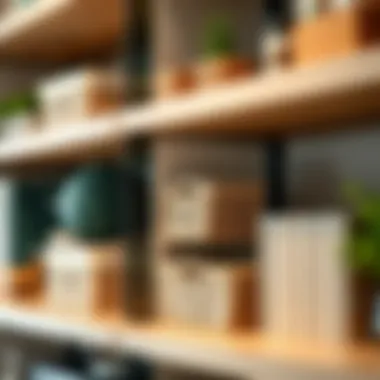

A living room is often the centerpiece of a home, serving as both a social hub and a personal retreat. Shelf dividers can play a significant role in curating a beautiful and inviting atmosphere. Here’s what to consider:
- Showcasing Collections: Whether it’s books, art pieces, or sundry knick-knacks, shelf dividers help highlight your favorite items while keeping them easy to reach.
- Layered Depth: By utilizing dividers, you can create a tiered display that draws the eye upward, adding depth to your room. This is particularly handy in smaller spaces where maximizing visual interest is key.
- Style Cohesion: Having a clear separation between decorative items ensures that each piece can shine without clashing with others. The right organization offers an elegant view without the clutter.
When guests visit, a well-organized living room speaks volumes about the thought put into the space. Shelf dividers, thus, don’t merely act as functional items but can also elevate the design aesthetic significantly.
"An organized space is an organized mind."
DIY Shelf Divider Projects
Creating your own shelf divider organizers can be a rewarding experience. Not only does it allow you to add a personal touch to your home, but it also offers functional solutions tailored to your specific needs. DIY projects often enable you to maximize the use of available materials, ensuring your space remains organized without breaking the bank. Plus, engaging with your creativity can serve as a stress-reliever, making the process enjoyable.
Materials Needed
Before diving into your DIY shelf divider projects, it’s essential to gather all the necessary materials. Here’s a handy list to get you started:
- Wood Boards: Choose plywood or MDF for sturdiness.
- Planks or Dowels: Useful for adjustable dividers.
- Ruler and Measuring Tape: For precise measurements.
- Saw: A handsaw or power saw, depending on your comfort level.
- Sandpaper: To smooth out rough edges.
- Paint or Wood Stain: For finishing touches, based on your decor.
- Screws or Brackets: For assembly.
- Drill: For making holes where necessary.
- Clamps: To hold pieces together while you assemble them.
Gathering these materials ensures that you will not have to make repeated trips to the hardware store, allowing for a smoother and more efficient project flow.
Step-by-Step Instructions
Here’s how you can create your very own shelf dividers:
- Measure Your Shelf Space: Determine the dimensions of your shelf. It helps if you know how wide and tall your space is to create dividers that fit perfectly.
- Cut the Wood: Using the saw, cut the wood boards or planks to your desired height and width. Remember the dimensions you measured in step one.
- Sand the Edges: Carefully sand the edges to prevent splinters. You want your dividers to be safe for your fingers and polished for the eye.
- Assemble: Using screws or brackets, attach the dividers to the shelf. If you’re making adjustable dividers, consider pre-drilled holes to allow flexibility.
- Finish It Off: Apply paint or stain to seal the wood. This step increases longevity while enhancing the aesthetic of the dividers.
- Place On Shelf: After ensuring everything is dried, place your dividers on the shelves and start organizing your items.
Making shelf dividers can be a practical and efficient task when you break it down into straightforward steps.
Customization Options
The beauty of DIY projects lies in your ability to personalize your creations. Here are several ideas to customize your shelf dividers further:
- Creative Paint Patterns: Use stencils or creative brush techniques to paint unique designs.
- Fabric Wrapping: For a softer touch, consider wrapping the dividers in fabric or wallpaper.
- Labeling: Add labels to sections of your dividers. You could use chalkboard paint for a rustic, interchangeable look.
- Decorative Cutouts: If you’re handy with tools, consider making decorative cutouts or designs in the wood itself for a modern visual flair.
- Lighting: For a unique effect, integrate small, low-power LED lights within or around your dividers to highlight your displayed items.
Creating your own shelf dividers not only helps in organizing but also opens a window for personal expression in design.
DIY projects like these empower you to blend functionality with creativity, meeting both your practical needs and personal style.
Purchasing Guide
Understanding how to procure shelf divider organizers is crucial — they can significantly enhance your organization efforts at home, ensuring not only functionality but also a visual appeal that reflects your style. A thorough purchasing guide will assist you in navigating the options available, making informed decisions tailored to your needs. This section will dissect where to buy these organizers, expectations regarding their price, and critical factors to keep in mind before making that all-important purchase.
Where to Buy
Online Retailers
When you're on the hunt for shelf divider organizers, online retailers like Amazon, Wayfair, and Ikea tend to be at the top of the list. The key characteristic of online stores is convenience; you can browse through an extensive selection from the comfort of your home, day or night.
What sets online retailers apart is their ability to provide detailed descriptions and customer reviews. With just a few clicks, you can see what others think about the products. Often, you can find unique features like adjustable dividers that you might not find in local stores. However, there are disadvantages, like the inability to physically inspect materials or see the true color until it arrives at your doorstep.
Advantages:
- Convenient shopping experience
- A vast array of options
- Customer reviews to assist in decision-making
- Often competitive pricing
Disadvantages:
- Cannot physically examine the product before buying
- Possible delivery issues or additional shipping costs
Local Stores
Local stores, like Home Depot or Target, also offer a diverse range of shelf divider organizers. Walking into a physical location allows you to experience the products first-hand. The tactile aspect is especially beneficial for understanding how durable or visually appealing an organizer may be in your own space.
A distinct feature of local stores is the immediacy; if you find what you're looking for, you can take it home right away. That instant gratification can be a compelling reason to shop brick-and-mortar. However, store inventories can be limited compared to what online options offer.
Advantages:
- Ability to see and touch products
- Immediate purchase—no waiting for shipping
- Potential for instant assistance from staff
Disadvantages:
- Limited selection, depending on the store
- Might encounter less competitive pricing than online
Price Range Expectations
When exploring the prices of shelf divider organizers, it's essential to factor in the material and design. Generally, you can expect prices to range from as low as $10 for basic plastic models to over $100 for designer wooden options. Adjustable and custom-fit organizers often sit in the mid-range, usually falling between $25 to $75.
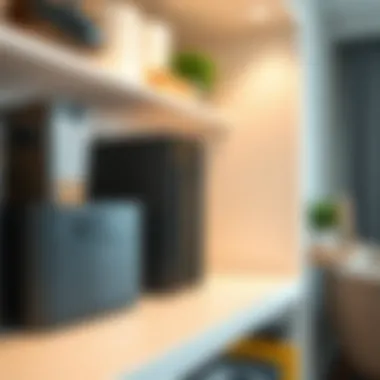

It's worth remembering that while a lower price may be tempting, it can sometimes be linked to inferior quality. In contrast, investing a bit more in higher-quality materials may prove cost-effective over the long haul, especially considering how often you use them.
What to Consider Before Buying
Before you pull the trigger on a purchase, keep a few things in mind:
- Space Size: Ensure that the organizer will fit comfortably on your shelf without overcrowding.
- Material Type: Consider how the material will withstand daily wear and tear.
- Aesthetic Appeal: Select designs that complement your existing decor.
- Functionality: Think about how you plan to use the dividers. Are you organizing books, dishes, or maybe craft supplies? Each might require a different type of organizer.
- Return Policy: Make sure you're aware of the seller’s return policy should the product not meet your expectations.
Taking these factors into account will not only make the buying experience smoother but will also guarantee that the organizers you choose will serve your needs well.
Maintenance and Care
Maintaining shelf divider organizers is an essential part of ensuring that they serve their purpose effectively. When ignored, dust, grime, and wear can not only compromise the functionality and aesthetics but also shorten their lifespan. Proper care keeps your space not only looking sharp but also functioning smoothly. This section will delve into specific cleaning techniques based on the material of your dividers, how to prevent damage, and guidelines on when it's time to consider replacements.
Cleaning Techniques by Material
Different materials require various care approaches:
- Wood: For wooden shelf dividers, avoid soaking them in water. Instead, use a soft, damp cloth with a drop of mild soap for any sticky spots. Wipe down regularly to prevent buildup. A periodic application of furniture oil can help maintain their luster.
- Metal: Metal dividers often are sturdier, but they can rust or accumulate dust. A microfiber cloth can effectively remove surface dirt. For deeper cleaning, a gentle solution of water and vinegar works wonders—just ensure to dry them thoroughly afterward to prevent streaks.
- Plastic: Plastic dividers are typically the easiest to clean. Warm soapy water combined with a gentle scrubber will clear away sticky residues. They can usually withstand mild abrasives, but test first on a hidden area.
- Fabric-Covered: These require delicate handling. Use a vacuum cleaner with an upholstery attachment to get rid of dust. For stains, a damp cloth and mild detergent should do the trick. Air dry completely to maintain shape and prevent mold growth.
Preventing Damage
Preventive measures are the unsung heroes of maintenance. Simple steps can extend the life of your organizers:
- Avoid Overloading: Each material has its limits. Overstuffing can lead your shelf dividers to bend or break. Keep it within recommended weight limits for the safety of your items.
- Placement Considerations: If dividers are exposed to direct sunlight for prolonged periods, this can lead to fading or warping. Consider placing them away from harsh light or using curtains to protect them.
- Control Moisture: For wood and fabric options, excess humidity can cause warping or mildew. A dehumidifier can be your best friend in such cases, particularly in damp climates.
When to Replace
Knowing when to let go of a shelf divider is just as crucial as maintaining it.
"A stitch in time saves nine."
Watch for:
- Visible Damage: Cracks, bends, or peeling materials are clear indicators that it might be time for a new divider. These defects not only look unsightly but can compromise the stability of your items.
- Discoloration: If your wooden or fabric dividers are fading or stained beyond cleaning, a fresh set can reinvigorate your space.
- Issues with Functionality: If they no longer hold items in place and allow things to topple over, then it's a sign that they need replacing to maintain organization.
Trends in Shelf Divider Organizers
In the ever-evolving world of home organization, shelf divider organizers are gaining momentum, not merely as functional tools but as essential components of modern design. Understanding these trends is pivotal for homeowners, designers, and DIY enthusiasts alike. The latest shifts in material choices, technology integration, and aesthetic considerations are not only shaping how we store our belongings but also the overall visual appeal of our living spaces.
Sustainable Materials
The rise of eco-consciousness has filtered into the realm of shelf dividers, with sustainable materials now taking center stage. Bamboo, for instance, is becoming a favorite due to its rapid growth and low environmental impact. This type of wood not only offers durability but also lends a natural look that fits seamlessly into organic design themes. Similarly, recycled plastics are making their mark, as they provide both utility and a nod toward reducing waste.
Adopting sustainable materials for shelf dividers does more than just align with ethical practices; it also translates into tangible benefits. They are often lighter, which makes installation easier, and they can provide a unique aesthetic appeal that plastic or metal alternatives may not match. If one is looking to spruce up a space while being kind to the planet, opting for materials like reclaimed wood or bioplastics makes for a conscientious choice.
Smart Dividers with Tech Integration
Next on the trend radar is the advent of smart technology finding its way into shelf organizers. Imagine a divider that can not only keep your items neatly arranged but also manage your inventory.
Some innovative designs include sensor technology that alerts users when specific items are running low. Furthermore, there are smart dividers that can interact with home management systems, ensuring that you always know what groceries need replenishing. This integration of technology into everyday organization tasks can boost efficiency and even save money. Being aware of such smart solutions can transform even the most chaotic of kitchens into models of efficiency.
Innovative Designs
Finally, let’s talk about the sheer creativity involved in the design of shelf divider organizers. Gone are the days of plain, utilitarian dividers; today’s options are a feast for the eyes. Stylish geometric shapes, vibrant colors, and multi-functional designs are all the rage.
For instance, adjustable dividers that not only separate your silverware from your cookbooks but also come in a sleek design elevate the visual appeal of your shelving as well. Also becoming increasingly popular are dividers that feature unique textures or patterns, allowing owners to express their personal style through mundane organizational tools.
"The best shelf dividers are those that reflect personality as much as they reflect order."
By considering sustainable materials, tech integration, and innovative designs, one can create environments that are both functional and stylish.
Final Thoughts on Shelf Divider Organizers
Shelf divider organizers are more than mere organizational tools; they’re essential players in crafting an efficient household. The conversation about these handy items extends beyond their basic function of separating and categorizing items. It touches on broader themes of space optimization, visual appeal, and personal expression in one’s living environment. As we wrap up the exploration of these versatile tools, it's essential to underscore their multifaceted benefits and considerations, emphasizing their growing relevance in contemporary living.
Summary of Key Points
In this article, key elements regarding shelf divider organizers have been thoroughly examined. Here’s a concise recap of what we've discussed:
- Definition and Purpose: Shelf divider organizers offer a systematic way to organize items, improving space efficiency and usability.
- Various Types: From adjustable to multi-tiered dividers, the diversity of options allows customization according to necessity and style.
- Material Variety: Whether wood, plastic, or metal, the choice of material significantly impacts durability and aesthetics.
- Design Considerations: It's vital to align organizational tools with the home’s style, ensuring practicality doesn't negate artistry.
- Usage Scenarios: These dividers shine in various settings, be it kitchens, offices, or even living rooms, highlighting their versatility.
- DIY Possibilities: For the crafty souls, the article delves into how one can embark on making personalized dividers, ensuring a perfect fit and flair for their space.
- Trends and Market Insight: Sustainability and incorporation of technology are emerging trends, keepin’ modern homes ahead.
This summary encapsulates the essence of utilizing shelf divider organizers within a household. Understanding these aspects equips readers to engage in informed discussions and make educated decisions.
Encouraging Organization
Consistency in organization can often feels like an uphill battle. However, introducing dividers into your spaces could be a game changer. They can not only boost functionality but can also serve as a graceful nod to your personal aesthetic. Here are a few points to ponder if you're looking to get organized:
- Embrace Simplicity: Simple and thoughtful arrangement can stave off clutter. Shelf dividers act as visual cues, directing items to their proper places.
- Maintain Your Space: Regularly scheduled reorganizing can keep areas looking neat and serene. With effective dividers, maintenance becomes less daunting.
- Visual Satisfaction: An organized shelf can be a small victory in a chaotic world. The satisfaction of visually aligning items can reflect on one's mindset.
- Create Themes: Explore thematic organization through color-coordinated or category-based dividers to make your shelves not only orderly but also visually appealing.
Ultimately, encouraging organization via shelf dividers is about creating a harmonious balance between function and flair. They channel creativity while establishing order, making it easier for everyone—homeowners, designers, and DIY enthusiasts alike—to enjoy the serenity that an organized space provides.
Just as a well-tended garden reflects a gardener's touch, an organized shelf speaks volumes about its owner. The choice to integrate dividers is a step towards refining this expression, encouraging both practicality and style throughout your home.




